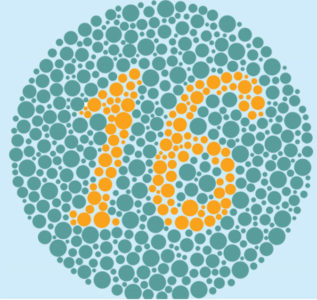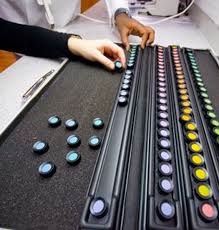Designers, print buyers and even press experts are in the habit of of visually inspecting an inkjet press sheet and “tweaking” the color to resemble a printed sample or based on an opinion of what makes the color “better.” No matter who is doing it, anyone responsible for color reproduction on inkjet should know that there are many factors which make this approach to color management highly inaccurate.
There are 3 major drivers of the way we see color: lighting, environment and human perception. Out of these 3, human perception is the most difficult one to control. Each individual has his or her own vision deficiencies. If you look around your print shop, you may notice that your print staff is mostly male and well over the legal drinking age (as in they haven’t been asked for their ID at a bar in a very long time.) Men are significantly more likely to have some form of color perception deficiency than women, and both men and women are more likely to experience vision changes as they age. As many as 8 percent of men and 0.5 percent of women with Northern European ancestry have the common form of red-green color blindness. So, some of the “color experts” in your shop may have a vision deficiency, others may have a color deficiency and some likely have both.
Below is an overview of the major categories of color “blindness.” More information on the likelihood of having a condition, passing on a condition and treating a condition can be found at the National Eye Institute.
Red-Green color blindness is most common and includes:
-
- Deuteranomaly: makes yellow and green appear more red and causes difficulty distinguishing violet from blue.
- Protanomaly: makes red, orange, and yellow appear greener and colors overall are seen as less bright.
- Protanopia: makes red appear as black and certain shades of orange, yellow, and green all appear as yellow.
- Deuteranopia: causes reds to be seen as brownish-yellow and greens to be seen as beige.
Blue-Yellow Color Blindness is rarer than red-green and includes:
- Tritanomaly: causes blue to appear greener and makes it difficult to distinguish yellow and red from pink.
Tritanopia: An extremely rare condition that causes blue to appear green and yellow to appear violet or light grey.
There is also a form of complete color blindness called monochromacy, which doesn’t allow any visual color experience at all.
With all of these variations in color perception, if you ask 10 people the color of a green grape, they may all say green. But, some only say this because they have been taught that the color of olives is green. It doesn’t mean that they see the true color. By the way, the “true color” is not what everyone votes on – it is the actual measurable, provable color. But visually and subjectively, the name of that color does not mean the same thing to everyone.
I found his out first hand a few years back when I went with my husband to pick out running shoes. The shoe salesman, Bob, kept showing him shoes and my husband began to get frustrated that Bob wan’t bringing the shoes he was asking for. My husband was diligently pointing at a specific pair, and Bob finally brought the ones which he wanted, which I was surprised to see where bright pink.
When I commented on his color choice, he said he thought they were gray. He was completely unaware of his color vision deficiency. When he said that pink would not be his color preference I wondered, if he can’t see the color, then how can he have an opinion on it? And, if he has an opinion, how can he make a decision if he can’t trust his eyes? What if Bob was color blind too? The answer is, he would be happily wearing pink sneakers that he thought were gray. That may not be mission critical when selecting your own shoes, but color vision is mission critical for your pressroom staff. Do any of them have vision deficiencies that they are completely unaware of?
There are many color tests on-line which evaluate for color deficiencies, and you may want to have your team use these to check their vision. Of course, the test is only effective if the lighting and monitor calibration are correct.

This on-line color vision test consists of 8 plates taken from the PIP 24 Plate Color Vision Test.
The Farnsworth Munsell Tests are far more sensitive and accurate at determining the type and extent of deficiency present, but are also more time consuming and have to be ordered. I have taken this test at various times throughout my career to track the difference that age makes in color perception. We all change to varying degrees over time whether we like it or not. Even with better than average color perception, I would never assess color subjectively for business purposes. I always work with color measurement data. Data is fact – everything else is an opinion.

Visually tweaking or modifying color on press is never an efficient or repeatable way to run production. Making your staff’s aware of their potential vision deficiencies will help catch color, as well as print quality issues, before they get to your customer. It’s always best to create a color managed workflow that references the same target color space as your customer’s file. If your device and paper selection allows you to match that color space, your variance should be limited. For output devices and paper combinations which may be smaller in reproducible gamut, target the color space which most closely fits your device.
Knowing the color capabilities of your inkjet device is very important, but understanding the color capabilities of your press crew is critical.
